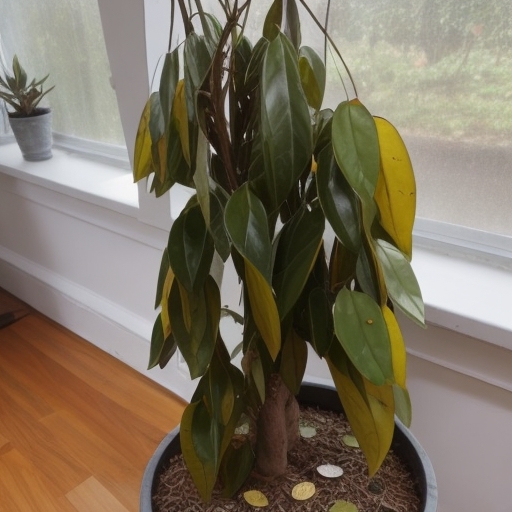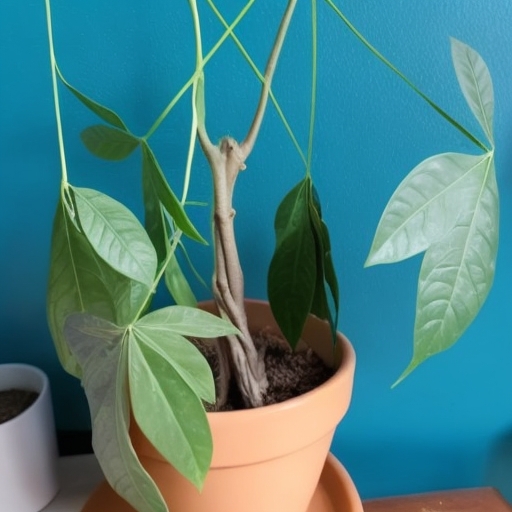Money Tree Problems Hub
Money trees (Pachira aquatica) are relatively low-maintenance plants, but they can still encounter issues that affect their health and appearance. Below are common categories of leaves problems that money tree owners may encounter, along with tips for identifying and addressing them:
Money Tree Underwatering

Signs or symptoms of underwatering in a money tree
Signs or symptoms of underwatering in a money tree include wilting, drooping leaves, dry and crispy leaf edges, and overall leaf curling. The soil may be dry to the touch, and the plant may appear generally limp and lacking in vitality. Underwatered money trees often show signs of stress, such as yellowing or browning leaves, as they struggle to retain moisture.
How to Fix Underwatering in a Money Tree
To fix underwatering in your money tree, start by thoroughly watering the plant, ensuring that the soil is moist but not waterlogged. Monitor the soil moisture levels regularly and water when the top inch of soil feels dry to the touch. Trim off any severely damaged or dead leaves to encourage new growth. Maintain proper humidity levels and environmental conditions to prevent future underwatering. With proper care and attention, your money tree can recover from dehydration and thrive once again.
Why are my money tree leaves yellow?
Money tree yellow leaves causes
How to fix yellow leaves on money tree
Money tree care yellow leaves
Money tree leaves turning yellow and brown
Yellowing leaves on Pachira aquatica
Money tree leaves drooping and yellow
How to save money tree with yellow leaves
Money tree leaves yellowing at edges
Brown Tips On Money Tree Leaves

Signs or Symptoms of Brown Tips on Money Tree Leaves:
Browning at Leaf Tips: The most noticeable sign is the browning of the tips of the leaves. The brown color may start at the very tip and gradually spread inward along the edges of the leaf.
Dry, Brittle Texture: The affected parts of the leaf may become dry and brittle to the touch, compared to the healthy parts of the leaf.
Crispy Edges: As the browning progresses, the edges of the affected leaves may become crispy or crunchy.
Gradual Progression: The browning typically starts at the tips of the leaves and may spread gradually towards the base of the leaf if the underlying issue is not addressed.
No Other Leaf Discoloration: Generally, the rest of the leaf remains green and healthy-looking, with the browning isolated to the tips.
No Yellowing: Unlike other types of leaf discoloration, such as yellowing, browning at the tips does not involve a change in overall leaf color.
Brown tips on money tree leaves are a common issue that can detract from the plant’s overall appearance. These brown tips, also known as leaf burn or leaf scorch, occur when the leaf cells become damaged and die, resulting in browning at the tips of the leaves. While unsightly, brown tips are usually not a sign of serious health issues and can often be remedied with proper care.
Possible Causes of Brown Tips On Money Tree Leaves:
Underwatering: Insufficient watering can lead to dryness in the leaf tips, causing them to turn brown and crispy.
Overfertilization: Excessive fertilization can cause a buildup of salts in the soil, leading to brown tips on the leaves.
Low Humidity: Money trees prefer humid environments, and low humidity levels can result in dry air that damages the leaf tips.
Excessive Sunlight: Direct sunlight, especially intense afternoon sun, can scorch the leaves and cause browning at the tips.
Water Quality: Poor water quality, such as using water high in salts or chlorine, can contribute to brown tips.
Root Bound: If the money tree is root-bound and unable to absorb water properly, it can lead to dryness and browning of the leaf tips.
Environmental Stress: Sudden changes in temperature, drafts, or dry air can stress the plant and result in brown tips.
How to fix brown tips on money tree leaves
To fix brown tips on money tree leaves, follow these steps:
Adjust Watering: Ensure your money tree is receiving adequate water. Water when the top inch of soil feels dry, and ensure proper drainage to prevent waterlogging.
Improve Humidity: Money trees prefer humid environments. Increase humidity by misting the leaves regularly, using a humidity tray, or placing a small humidifier nearby.
Avoid Overfertilization: Reduce the frequency of fertilization or use a diluted fertilizer to avoid buildup of salts in the soil, which can lead to leaf burn.
Proper Lighting: Place your money tree in a location with bright, indirect light. Avoid direct sunlight, especially intense afternoon sun.
Water Quality: Use room temperature water that is free from chlorine and salts. If necessary, use filtered or distilled water.
Repotting: If your money tree is root-bound, consider repotting it into a larger container with fresh, well-draining soil.
Prune Dead Areas: Trim off any dead or browned tips using clean, sharp scissors. This will improve the appearance of the plant and encourage new growth.
Monitor and Adjust: Regularly check your plant for signs of stress or new brown tips. Adjust your care routine as needed to maintain a healthy environment for your money tree.
By addressing these factors, you can help your money tree recover from brown tips and promote healthy growth.
Why money tree leaves turning brown at tips
Brown tips money tree leaves
How to fix brown tips money tree leaves
Money tree care brown tips
Money tree leaves browning edges
Brown edges Pachira aquatica leaves
Money tree leaf tips turning brown
Tips preventing brown tips money tree leaves
Money tree leaf care tips brown tips
Money Tree Leaves Dropping

Signs or Symptoms of Money Tree Leaves Dropping:
Leaf Yellowing: Before leaves drop, they may turn yellow. This can indicate various issues, including overwatering, underwatering, or nutrient deficiencies.
Leaf Wilting: Leaves may become limp and droopy before they fall off. This can be a sign of underwatering, overwatering, or environmental stress.
Excessive Leaf Shedding: While some leaf shedding is normal, an excessive amount of leaves dropping at once or over a short period can indicate a problem.
Leaf Dryness or Brittleness: Leaves may become dry or brittle before they drop. This can be a result of underwatering, low humidity, or other environmental factors.
Leaf Spotting or Browning: Some leaves may develop spots or browning before they drop. This can be a sign of disease or pest infestation.
Lower Leaf Drop: Money trees often drop lower leaves as part of their natural growth process. However, if the dropping occurs higher up on the plant, it may indicate a problem.
Stress Signs on Other Leaves: Other leaves on the plant may show signs of stress, such as discoloration or curling, before they drop.
Overall Plant Health: Dropping leaves can be a symptom of overall plant health. If the plant is otherwise healthy and growing new leaves, the leaf drop may not be a cause for concern. However, if the plant is struggling or showing other signs of distress, the leaf drop may indicate a problem.
How to fix money tree leaves dropping
To fix the issue of money tree leaves dropping, follow these steps:
Check Watering: Ensure you are watering your money tree correctly. Overwatering and underwatering can both cause leaf drop. Water when the top inch of soil feels dry, and adjust watering frequency based on the plant’s needs and environmental conditions.
Adjust Humidity: Money trees prefer humid environments. Increase humidity by misting the leaves regularly, using a humidity tray, or placing a small humidifier nearby.
Inspect for Pests: Check your money tree for signs of pests, such as spider mites or scale insects, which can cause leaf drop. Treat any infestations promptly with insecticidal soap or neem oil.
Lighting: Ensure your money tree is getting the right amount of light. They prefer bright, indirect light. If the plant is not getting enough light, consider moving it to a brighter location.
Temperature and Drafts: Money trees are sensitive to temperature changes and drafts. Avoid placing them near drafty windows or vents and protect them from sudden temperature fluctuations.
Fertilization: Avoid overfertilizing your money tree, as this can lead to stress and leaf drop. Use a balanced, water-soluble fertilizer diluted to half strength during the growing season.
Pruning: Remove any dead or damaged leaves and branches. This can help redirect the plant’s energy to healthy growth.
Repotting: If your money tree is root-bound, consider repotting it into a larger container with fresh, well-draining soil. This can improve its overall health and reduce stress.
Environmental Factors: Consider other environmental factors that may be affecting your plant, such as air quality, temperature, and humidity levels. Make adjustments as needed to create a more suitable environment for your money tree.
Why are my money tree leaves falling off?
Money tree dropping leaves solutions
How to prevent money tree leaves from dropping
Money tree care leaves dropping
Money tree losing leaves
Money tree leaves falling off at the bottom
Money tree leaf drop reasons
Money tree leaves dropping in winter
Money tree dropping leaves after repotting